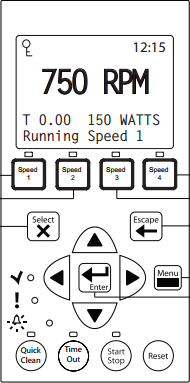Price
Horsepower and RPM Range
Usability
Notice that both pumps have a “Quick Clean” button. The “Quick Clean” button runs the pump at a higher speed for a certain amount of time. The Intelliflo runs the pump at 3450 RPM for 10 Mins. This is hardly enough to vacuum a pool under this setting. Although the quick clean settings can be changed to different speeds and longer periods of time (up to 10 hours), this is not something that comes usable out of the box. The Hayward EcoStar “Quick Clean” button runs the pump at 3450 RPM for 60 minutes by default. This gives ample time to vacuum and circulate chemicals through the pool system when servicing a pool out of the box.
The Pentair IntelliFlo has more controls, options, and settings that can be used to customize many aspects of the pump. This comes at a price, non-intuitive menu navigation, complex menu structure, passwords, and plain difficulty of use. Although these settings and customizations can be seen as a nice feature, they will only be used under special circumstances which is rarely seen under an average residentail or even commercial pool. The simple out of the box usability has Hayward EcoStar a leg up in this category.
Efficiency and Cost
3450 RPM
Intelliflo: 97 GPM, 2720 Watts, 2.14 Gallons/Watt-hr
EcoStar: 98 GPM, 2324 Watts, 2.53 Gallons/Watt-hr
1000 RPM
Intelliflo: 30 GPM, 140 Watts, 12.86 Gallons/Watt-hr
EcoStar: 28 GPM, 90 Watts, 17.5 Gallons/Watt-hr
Looking at the top speed (3450 RPM) both pumps have about the same throughput which means the safe assumption that they are using the same size impellor. This allows the direct comparison at any RPM. At the top speed the Hayward EcoStar pushes slightly more water while using less electricity. The efficiency, at Gallons/Watt-hr, shows the EcoStar at 18% more efficient at 3450 RPM. At lower speeds (1000 RPM), the difference is much more. The EcoStar shows 36% more efficiency per Watt-hr leaving the Hayward EcoStar considerable more efficient that the Pentair IntelliFlo throughout the entire comparable RPM range.
When looking at the energy consumed by a pool pump, the energy is measured by Watts (W) or Kilowatts (kW). These measurements can help determine the operating cost of the pump by the equation below.
(Power Consumption of Pump) X (Cost of Electricity) = (Cost of Pump Operation per Hour)
As an example, the above equation can compare a Centurion 1 HP pump to a Hayward EcoStar to see how much estimated savings a pool owner can get by switching over to a variable speed pump. This is under the assumption that a 1 HP pump runs at 1794 W and the cost of electricity on Oahu is an average of $0.36 per kWh. We can find the Watts of a pump by the label on the side. Multiply Volts (230) by Amps (7.8) and you get 1794 Watts.
1. 1 HP pool pump operating at 1794 W. Cost of electricity = $0.36 per kWh
2. Convert Watts to Kilowatts: 1794 W / 1000 = 1.794 kW
3. 1.794 kW X $0.36 = $0.65 per hour
4. $0.65 per hour at 8 hours a day = $5.17 per day and $155.00 per 30 day month
1. Hayward EcoStar operating at 90 W (1000 RPM). Cost of electricity = $0.36 per kWh
2. Convert Watts to Kilowatts: 90 W / 1000 = .09 kW
3. .09 kW X $0.36 = $.03 per hour
4. $.03 per hour at 8 hours a day = $0.26 per day and $7.78 per 30 day month
The above example will save the owner an estimated $147.22 per month on electricity. Just as an example, there are pool companies that will install these variable speed pumps in your pool for about $2000.00 (Hawaii Pool and Spa will beat that price – Contact us now). The return on investment (ROI) will be 14 months or over 1 year. Hawaii Pool and Spa will install a variable speed pump for less than $2000.00 to give you a faster ROI.
There are variables in the above example. A 1 HP pool pump may operate at above 1794 W in a true to life scenario. The variable speed pump will most likely not be running at 1000 RPM but slightly higher. Also, if a suction side automatic cleaner is installed in the pool the pump speed will need to be raised for an hour a day to allow the cleaner to keep leaves and debris off the pool bottom. Finally, if you have Pool Service Technician service your pool once a week he or she will most likely put the pump on “Quick Clean” setting or raise the RPM to get better suction and circulation while servicing the pool. All of these variables may increase or decrease your actual savings for pool pump operation.




 RSS Feed
RSS Feed